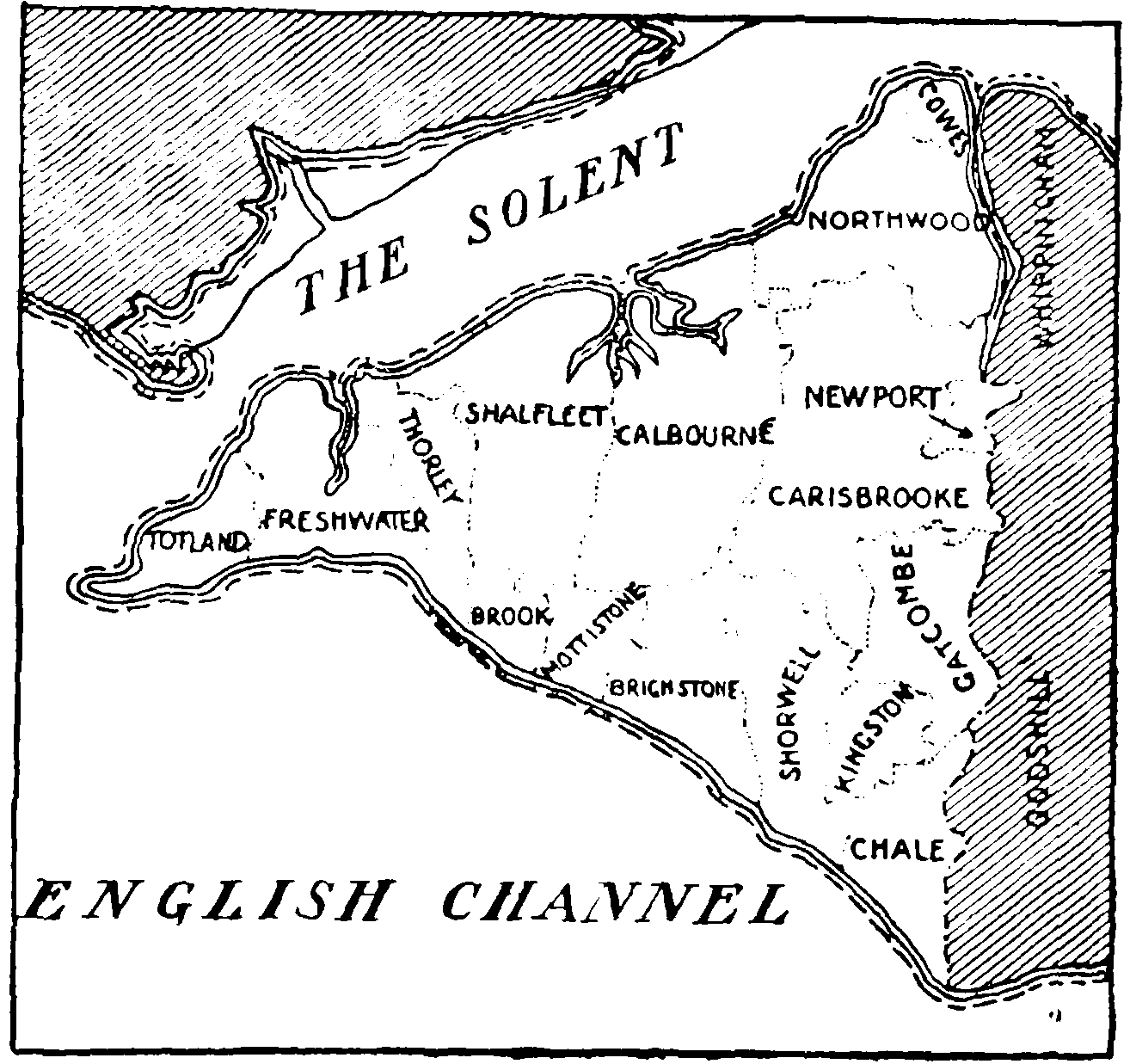Pages 209-210
A History of the County of Hampshire: Volume 5. Originally published by Victoria County History, London, 1912.
This free content was digitised by double rekeying. All rights reserved.
THE LIBERTY (fn. 1) OR HUNDRED OF WEST MEDINE (fn. 2)
CONTAINING THE PARISHES OF
| BRIGHSTONE | GATCOMBE | NORTHWOOD |
| BROOK | KINGSTON | SHALFLEET |
| CALBOURNE | MOTTISTONE | SHORWELL |
| CARISBROOKE | NEWPORT | THORLEY |
| CHALE | NEWTOWN (fn. 3) | YARMOUTH (fn. 4) |
| FRESHWATER | ||
At the time of the Domesday Survey the whole of the Isle of Wight seems to have been included in the three hundreds of Bowcombe, Hemreswel and Calbourne. (fn. 5) Of these Bowcombe, which contained the greater part of the Island, included Calbourne (fn. 6); the latter was described as 'Cauborne Hundret which lies in Bouecombe Hundret,' (fn. 7) and contained only the manor of Swainstone, the estate of the Bishop of Winchester in the Island. It was therefore known indifferently as the hundred of Calbourne or Swainstone, and was probably more of the nature of a liberty, being exempt from suit at the hundred of Bowcombe. Thus in 1316 it was known as the liberty of Swainstone, (fn. 8) and separate courts were held for it from the 13th (fn. 9) to the 17th century. During the 13th and 14th centuries it contained, besides the manor of Swainstone, to the lord of which the hundred pertained, (fn. 10) the manors of Limerstone in Brighstone, Atherfield in Shorwell, Thorley and part of Whippingham. (fn. 11)

Index Map to the Liberty of West Medine
Hemreswel Hundred included Yarmouth, 'Soet,' which may, perhaps, be identified with Sheat in Gatcombe or with Shute in Brighstone, and the unidentified holding of 'Lenimcode.' (fn. 12) It had disappeared as a hundred before the middle of the 13th century, when the existing Hundred Rolls for Hampshire begin.
Before 1182 (fn. 13) the Island was divided into the two hundreds of East and West Medine, which appear on the Pipe Roll of that year as 'Est medehundredum' and 'West medehundredum,' and in 1271–2 the hundred of Freshwater, belonging to the lords of the manor of Freshwater (fn. 14) and containing Freshwater, Weston and Northinton, made its appearance in the Hundred Rolls. (fn. 15) Like Swainstone, it was called a liberty in 1316, (fn. 16) and existed at least as late as the beginning of the 17th century, when it still contained only the manors of Freshwater, Weston, Braybeof and Norton in the parish of Freshwater. (fn. 17)
The hundred of West Medine, which during the 13th and 14th centuries contained the hamlet of Cadland on the mainland, (fn. 18) is at the present day of the same extent as in 1831, having absorbed the ancient hundreds of Hemreswel, Calbourne and Freshwater, and includes the whole of the Island on the western side of the Medina River. The hundred belonged to the lords of the Island, (fn. 19) and in it they claimed wreck of the sea, return of writs, estreats of summonses, pleas of namii vetiti, view of frankpledge, infangenthef, pillory, cucking-stool, tumbril and gallows, and the assize of bread and ale, and waif and free chase throughout the Island. The king had no coroner in the Island, the constable of Carisbrooke Castle fulfilling that office. (fn. 20) The courts for the hundred of West Medine were held in the time of Henry VIII at 'Westmedine le Pitte.' (fn. 21) Owing to a note left by Sir John Oglander (1595–1648), this pit is capable of identification. He says: 'Observe this that the law dayes for our Island wase kept, for the West in the pitt by Shyde downe. . . . Wherefore you shall find on all the Court rolls that are antient, West Medine le Pitt, East Medine le Hatte,—the places where they were kept.' (fn. 22) The chalk-pit, still in use, is at the back of Shide station. Courts held in April 1605 give in the West Medine the tithings of Shide, Gatcombe, Chale, Chillerton, Atherfield, South Shorwell, North Shorwell, Kingston, Bowcombe, Mottistone, Brook, Compton, Afton, Thorley, Ningwood, Shalfleet, Park, Carisbrooke, Watchingwell, Northwood and Calbourne, and separate courts were held for the hundreds of Swainstone and King's Freshwater.
In the 14th century the Island was divided into nine districts for militia purposes, and in the 16th century into ten districts called centons, each under a centoner, a resident landowner, in command of a lieutenant and from 150 to 200 men with a number of 'hobelers' and watchmen. (fn. 23)


